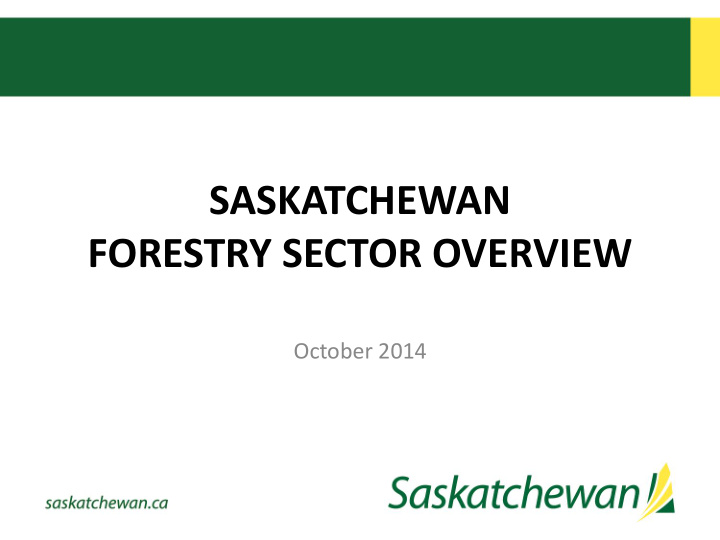



SASKATCHEWAN FORESTRY SECTOR OVERVIEW October 2014
Presentation Content • Forestry Development Branch • Timber Resource • Forest Industry Overview • Current Sales, Exports and Markets • Investment Climate and Export Potential
Ministry of the Economy Forestry Development Branch MANDATE • Facilitate growth and development of Saskatchewan’s forestry sector KEY RESPONSIBILITIES: • Investment attraction; • Facilitate export market growth; • Enhance industry competitiveness; • Explore new forest products; • Monitor and track key economic indicators; • Ensure a market based and competitive timber royalty system; and • Manage impacts created by trade agreements.
Ministry of the Economy Forestry Development Branch To Help Achieve its Mandate, Forestry Development Branch Works closely with: • The Forestry Industry, Wood Processing Companies, Saskatchewan Trade and Export Partnership (STEP), FPInnovations and other non-government organizations • Ministry of Environment, Forest Service Branch • Responsible for management and regulation of Saskatchewan’s provincial forests. • Ministry of the Economy, First Nations, Metis and Northern Economic Development • Responsible for strengthening and expanding Aboriginal and Northern business opportunities • Ministry of the Economy, Labour Market Development • To identify employment needs within the forestry sector and overcome shortages of workers that limit the sector’s growth potential • Saskatchewan and Canada’s Trade Commissioners • To promote Saskatchewan’s forest products and our industry’s ability to operate competitively in the global market
Saskatchewan’s Timber Resource
Timber Resource • Saskatchewan has 34.3 million hectares of forest • Commercial Forest Zone contains 11.7 million hectares, of which 5.3 million hectares is productive forest and available for commercial timber harvesting • Annual Allowable Cut is 8.2 million m 3 – 4.8 coniferous trees and 3.4 deciduous trees
Commercial Trees Species (59% Coniferous, 41% Deciduous) Jack Pine 3% 4% White Spruce 26% Black Spruce Balsam Fir 34% Trembling Aspen 16% Balsam Poplar 15% 2% White Birch * Based on Percent of Annual Allowable Cut
Forest Industry Overview • Northern Saskatchewan's second largest industry (after mining) • Normally over $1 billion in forest products sales and directly employs over 4000 people • 80% of forest products are exported to other countries, primarily United States (lumber and panels), China and Indonesia (pulp) • Well established and competitive with leading-edge technology • 11 large forest products manufacturing facilities: – 2 pulp mills (total capacity: 750,000 tonnes) – 2 OSB mills (total capacity: 1.4 billion sq. ft. = 1.2 million m 3 ) – 1 plywood mill (capacity: 135 million sq. ft. = 120,000 m 3 ) – 6 saw mills (total capacity: 605 million bd. ft. = 950,000 m 3 ) • Over 100 smaller businesses producing a variety of forest products
Forest Products Exports Pulp & Paper Plywood & OSB Lumber Other Forest Products $1,000 $900 $800 (Millions of Canadian Dollars) $700 Value of Foreign Exports $600 $500 $400 $300 $200 $100 $0 2004 2005 2006 2007 2008 2009 2010 2011 2012 2013
Change In Forest Products Markets 2005 2013 Japan Other Lumber 2% 1% US Canada US Canada 59% 58% 41% 39% Other Plywood & OSB 1% Japan 3% US Canada Canada US 78% 43% 18% 57% South Vietnam Pulp & Paper South Korea 1% Korea 2% Other Italy 1% 15% 2% India US China Germany 3% Indonesia 47% 70% 3% 25% Canada China 24% 7%
* Based on volume of shipments
Investment Climate & Export Potential • Saskatchewan’s forests are sustainably managed and our forest industry is globally competitive • Strong government support for forestry sector growth and development • Significantly underutilized timber resource presents substantial new business investment opportunities and increased forest products export potential – Existing forest industry configuration only requires 80% of AAC: • Over 1.5 million m 3 of timber available for new forest products mills • today, harvesting only 45.7% because some mills still closed
Example of Saskatchewan’s Forest Industry Global Market Potential
Saskatchewan Wood Export Potential Related To Global Wood Flows • The Russian logging industry will face a lack of harvestable timber in 10 to 20 years (The Moscow Times, 30.09.2014) • BC lumber output is slowing (2015+) and is “not offset by other Canadian regions” (Wood Markets International, 2014) • United States new housing starts improving in 2015. US and Asian/China demand for Canadian SPF remains strong to increasing (RISI)
Key Aspects of Global Wood Supply • Regions with tightening softwood timber resources or increasing access constraints: China, India, BC, Quebec, Western United States, Russia, Northern Europe • Saskatchewan, although small in global contribution potential relative to other Canadian provinces, is the only province with AAC surplus available • Quality of our softwood is equivalent to that in other boreal forests globally • Future potential to compete successfully for the highest price bidder globally
Timber Harvest History Actual Harvest Annual Allowable Cut ( ) % of AAC Utilized 9,000,000 8,000,000 7,000,000 Growth Plan Objective: 6,000,000 Actual Harvest Volume (m 3 ) Increase timber harvesting by (66%) 50% by 2020 (Baseline year 2012/13) (63%) 5,000,000 (57%) (57%) (54%) (53%) 4,000,000 (48%) (45%) (42%) (34%) 3,000,000 (28%) (29%) (27%) 2,000,000 (22%) (15%) 1,000,000 0 Operating Year *Does not include timber harvest from other Crown lands or private lands.
Investment Climate & Export Potential • Competitive forest products manufacturing costs and taxes • Competitive and market based timber royalty system • Results-based regulatory framework • Well-established transportation network providing access to North American and offshore markets • Well-trained, reliable and productive workforce, and…
Investment Climate & Export Potential • We have a potential for growth, not only in the commodity forest products of lumber, panels and pulp, but… • We have growth potential through increased value-added production by using both: – commodity forest products, and ; – residuals from those manufacturing processes. • Growth in our forestry sector also promotes growth in the associated supply industries.
For more information contact: Forestry Development Branch Saskatchewan Ministry of the Economy (306) 953-3785 forestrydevelopmentbranch@gov.sk.ca http://economy.gov.sk.ca/Forestry
Recommend
More recommend